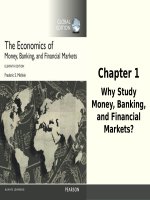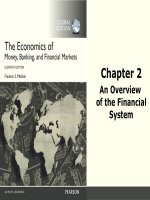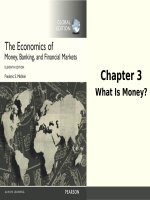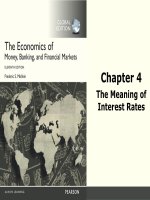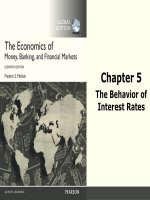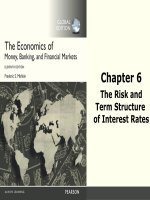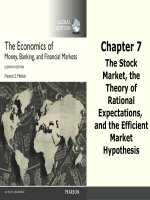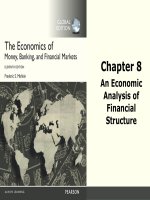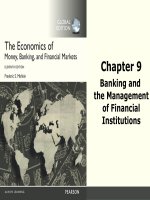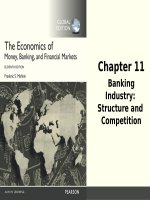The economics of money, banking, and financial institutions (11th edition) by f s mishkin ch1 why study money, banking, and financial markets
Bạn đang xem bản rút gọn của tài liệu. Xem và tải ngay bản đầy đủ của tài liệu tại đây (918.58 KB, 29 trang )
Chapter 1
Why Study
Money, Banking,
and Financial
Markets?
19-1
© 2016 Pearson Education Ltd. All rights reserved.
Preview
• To examine how financial markets such as
bond, stock and foreign exchange markets
work
• To examine how financial institutions such as
banks, investment and insurance companies
work
• To examine the role of money in the
economy
1-2
© 2016 Pearson Education Ltd. All rights reserved.
Learning Objectives
• Recognize the importance of financial
markets in the economy.
• Describe how financial intermediation and
financial innovation affect banking and the
economy.
• Identify the basic links among monetary
policy, the business cycle, and economic
variables.
• Explain the importance of exchange rates in
a global economy.
1-3
© 2016 Pearson Education Ltd. All rights reserved.
Why Study Financial Markets?
• Financial markets are markets in which
funds are transferred from people and firms
who have an excess of available funds to
people and firms who have a need of funds
1-4
© 2016 Pearson Education Ltd. All rights reserved.
The Bond Market and Interest Rates
• A security (financial instrument) is a claim
on the issuer’s future income or assets.
• A bond is a debt security that promises to
make payments periodically for a specified
period of time.
• An interest rate is the cost of borrowing or
the price paid for the rental of funds.
1-5
© 2016 Pearson Education Ltd. All rights reserved.
Figure 1 Interest Rates on Selected
Bonds, 1950–2014
Source: Federal Reserve Bank of St. Louis, FRED database: />
1-6
© 2016 Pearson Education Ltd. All rights reserved.
The Stock Market
• Common stock represents a share of
ownership in a corporation.
• A share of stock is a claim on the residual
earnings and assets of the corporation.
1-7
© 2016 Pearson Education Ltd. All rights reserved.
Figure 2 Stock Prices as Measured by the
Dow Jones Industrial Average, 1950–2014
Source: Federal Reserve Bank of St. Louis, FRED database: />
1-8
© 2016 Pearson Education Ltd. All rights reserved.
Why Study Financial Institutions
and Banking?
• Financial intermediaries: institutions that
borrow funds from people who have saved and in
turn make loans to other people.
– Banks: accept deposits and make loans
– Other financial institutions: insurance companies, finance
companies, pension funds, mutual funds and investment
companies
• Financial innovation: the development of new
financial products and services
– Can be an important force for good by making the
financial system more efficient
1-9
© 2016 Pearson Education Ltd. All rights reserved.
Why Study Financial Institutions
and Banking?
• Financial crises: major disruptions in
financial markets that are characterized by
sharp declines in asset prices and the
failures of many financial and nonfinancial
firms.
1-10
© 2016 Pearson Education Ltd. All rights reserved.
Why Study Money and Monetary
Policy?
• Evidence suggests that money plays an
important role in generating business
cycles.
• Recessions (unemployment) and
expansions affect all of us.
• Monetary theory ties changes in the money
supply to changes in aggregate economic
activity and the price level.
1-11
© 2016 Pearson Education Ltd. All rights reserved.
Money, Business Cycles, and
Inflation
• The aggregate price level is the average
price of goods and services in an economy
• A continual rise in the price level (inflation)
affects all economic players
• Data shows a connection between the
money supply and the price level
1-12
© 2016 Pearson Education Ltd. All rights reserved.
Figure 3 Money Growth (M2 Annual Rate) and the
Business Cycle in the United States 1950–2014
Source: Federal Reserve Bank of St. Louis, FRED database: />
1-13
© 2016 Pearson Education Ltd. All rights reserved.
Figure 4 Aggregate Price Level and the Money
Supply in the United States, 1950–2014
Source: Federal Reserve Bank of St. Louis, FRED database: />
1-14
© 2016 Pearson Education Ltd. All rights reserved.
Figure 5 Average Inflation Rate Versus Average Rate
of Money Growth, Selected Countries, 2003-2013
Source: International Financial Statistics. />
1-15
© 2016 Pearson Education Ltd. All rights reserved.
Money and Interest Rates
• Interest rates are the price of money
• Prior to 1980, the rate of money growth and
the interest rate on long-term Treasury
bonds were closely tied
• Since then, the relationship is less clear but
the rate of money growth is still an
important determinant of interest rates
1-16
© 2016 Pearson Education Ltd. All rights reserved.
Figure 6 Money Growth (M2 Annual Rate) and Interest
Rates (Long-Term U.S. Treasury Bonds), 1950–2014
Source: Federal Reserve Bank of St. Louis, FRED database: />
1-17
© 2016 Pearson Education Ltd. All rights reserved.
Fiscal Policy and Monetary Policy
• Monetary policy is the management of the
money supply and interest rates
– Conducted in the U.S. by the Federal Reserve System (Fed)
• Fiscal policy deals with government spending
and taxation
– Budget deficit is the excess of expenditures over revenues
for a particular year
– Budget surplus is the excess of revenues over
expenditures for a particular year
– Any deficit must be financed by borrowing
1-18
© 2016 Pearson Education Ltd. All rights reserved.
Figure 7 Government Budget Surplus or Deficit
as a Percentage of Gross Domestic Product,
1950–2013
Source: Economic Report of the President, Table B79 at />
1-19
© 2016 Pearson Education Ltd. All rights reserved.
The Foreign Exchange Market
• The foreign exchange market: where
funds are converted from one currency into
another
• The foreign exchange rate is the price of
one currency in terms of another currency.
• The foreign exchange market determines
the foreign exchange rate.
1-20
© 2016 Pearson Education Ltd. All rights reserved.
Why Study International Finance
• Financial markets have become increasingly
integrated throughout the world.
• The international financial system has
tremendous impact on domestic economies:
– How a country’s choice of exchange rate policy
affect its monetary policy?
– How capital controls impact domestic financial
systems and therefore the performance of the
economy?
– Which should be the role of international
financial institutions like the IMF?
1-21
© 2016 Pearson Education Ltd. All rights reserved.
Figure 8 Exchange Rate of the U.S.
Dollar, 1970–2014
Source: Federal Reserve Bank of St. Louis, FRED database: />
1-22
© 2016 Pearson Education Ltd. All rights reserved.
The International Financial System
• Financial markets have become increasingly
integrated throughout the world.
• The international financial system has
tremendous impact on domestic economies:
– How a country’s choice of exchange rate policy
affect its monetary policy?
– How capital controls impact domestic financial
systems and therefore the performance of the
economy?
– Which should be the role of international
financial institutions like the IMF?
1-23
© 2016 Pearson Education Ltd. All rights reserved.
How We Will Study Money, Banking,
and Financial Markets
• A simplified approach to the demand for
assets
• The concept of equilibrium
• Basic supply and demand to explain
behavior in financial markets
• The search for profits
• An approach to financial structure based on
transaction costs and asymmetric
information
• Aggregate supply and demand analysis
1-24
© 2016 Pearson Education Ltd. All rights reserved.
Appendix 1:
Defining Aggregate Output, Income, the
Price Level, and the Inflation Rate
1-25
© 2016 Pearson Education Ltd. All rights reserved.
